National Service Act 1939 Worksheets
Do you want to save dozens of hours in time? Get your evenings and weekends back? Be able to teach about the National Service Act 1939 to your students?
Our worksheet bundle includes a fact file and printable worksheets and student activities. Perfect for both the classroom and homeschooling!
Resource Examples
Click any of the example images below to view a larger version.
Fact File
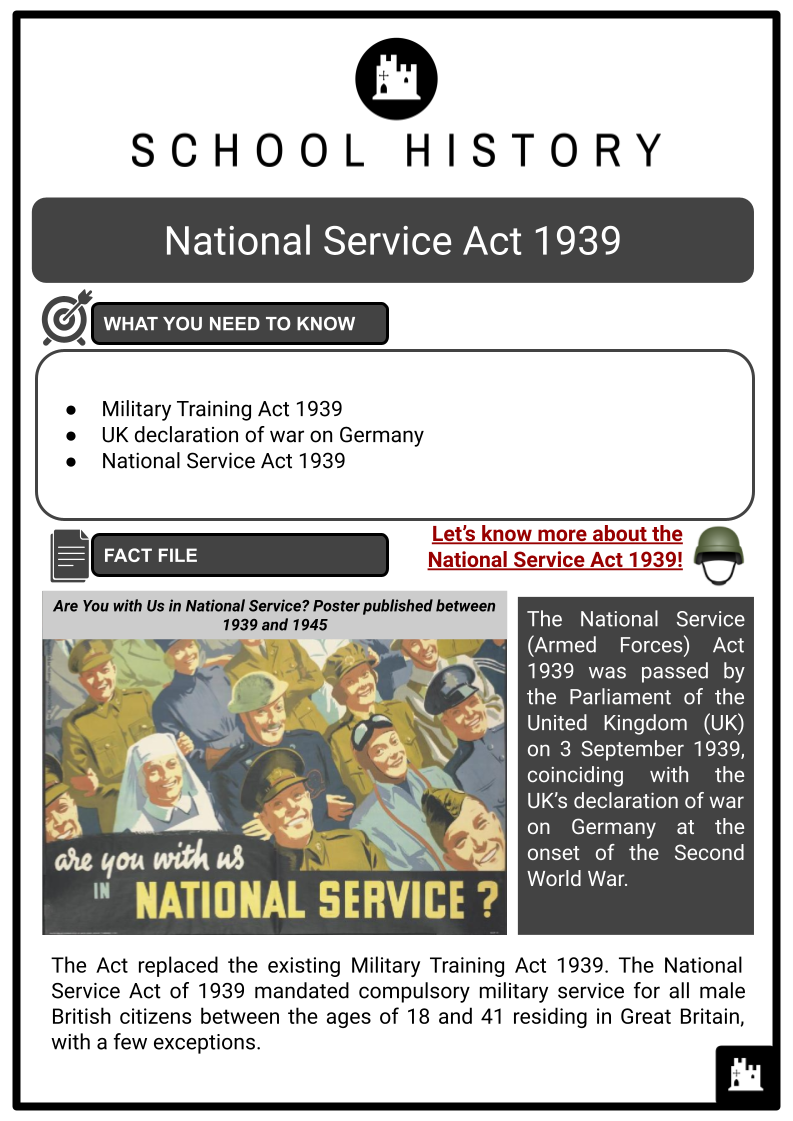
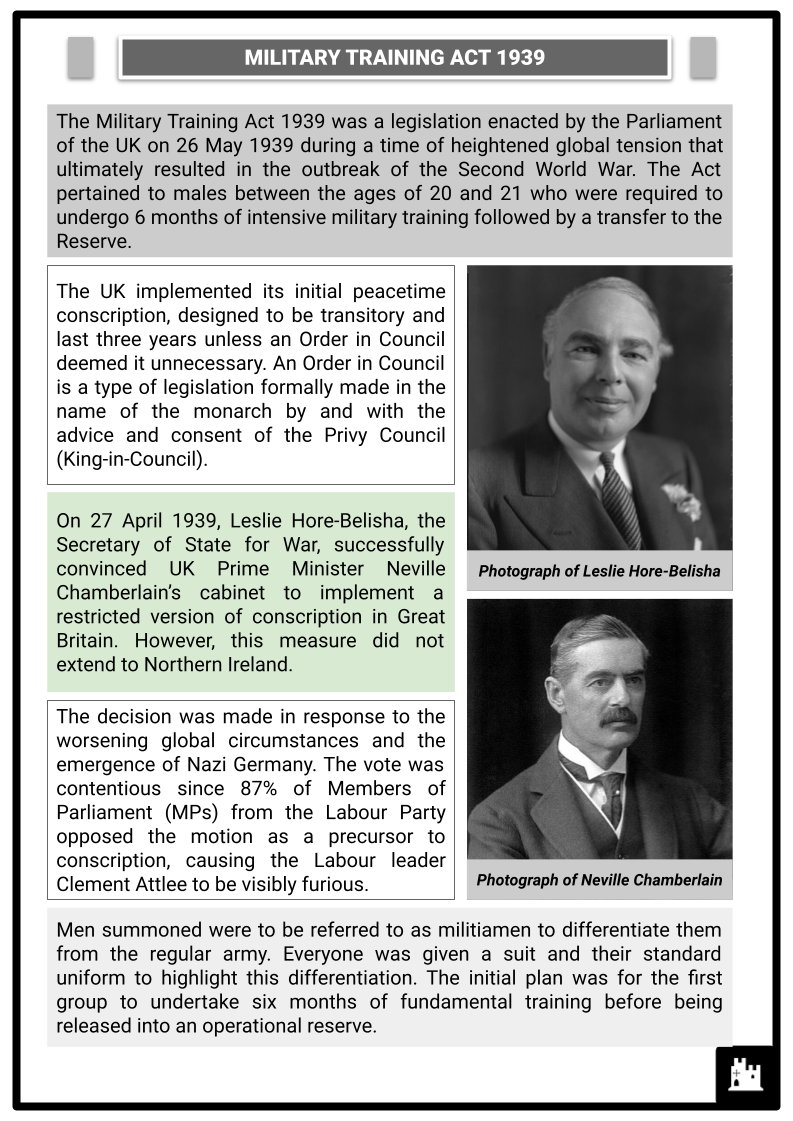
Student Activities
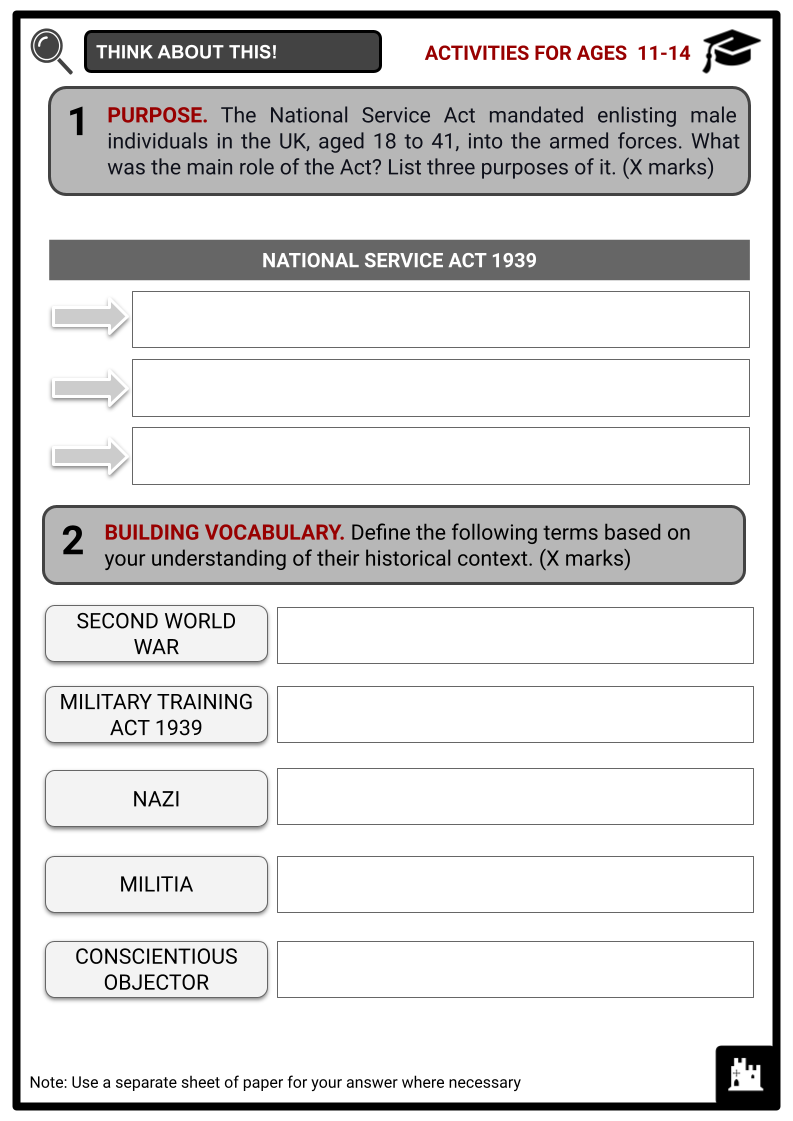
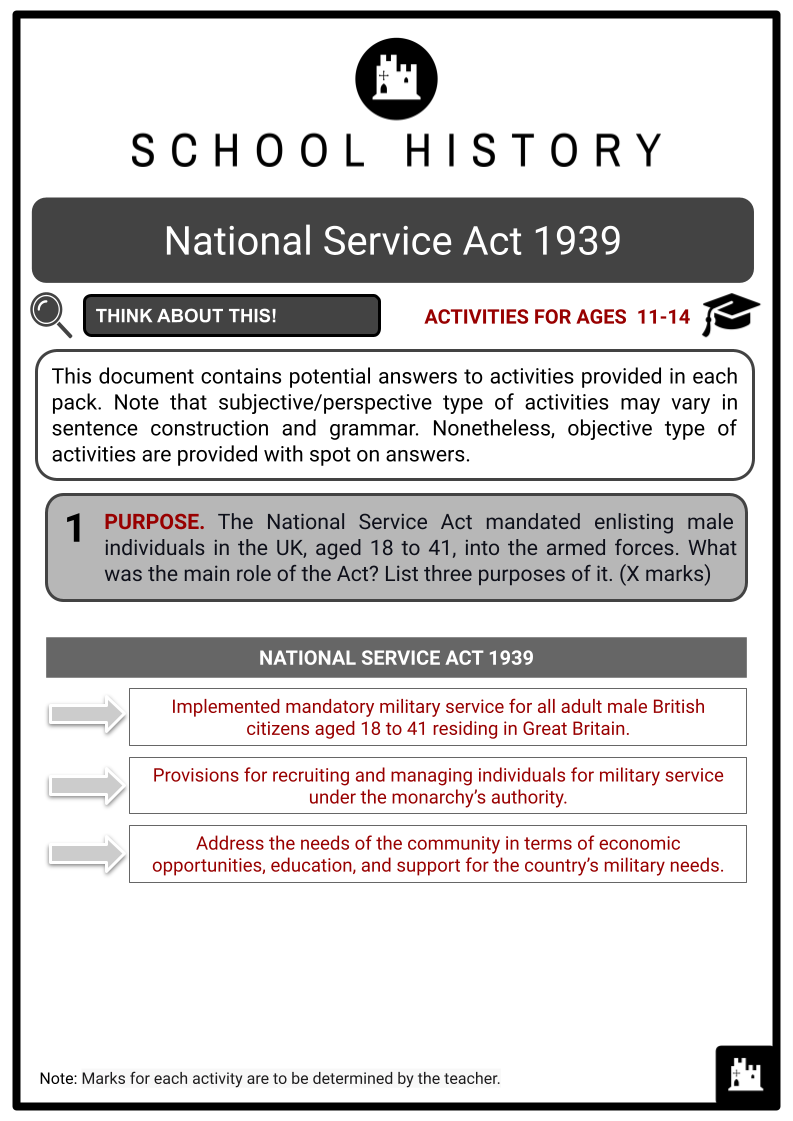
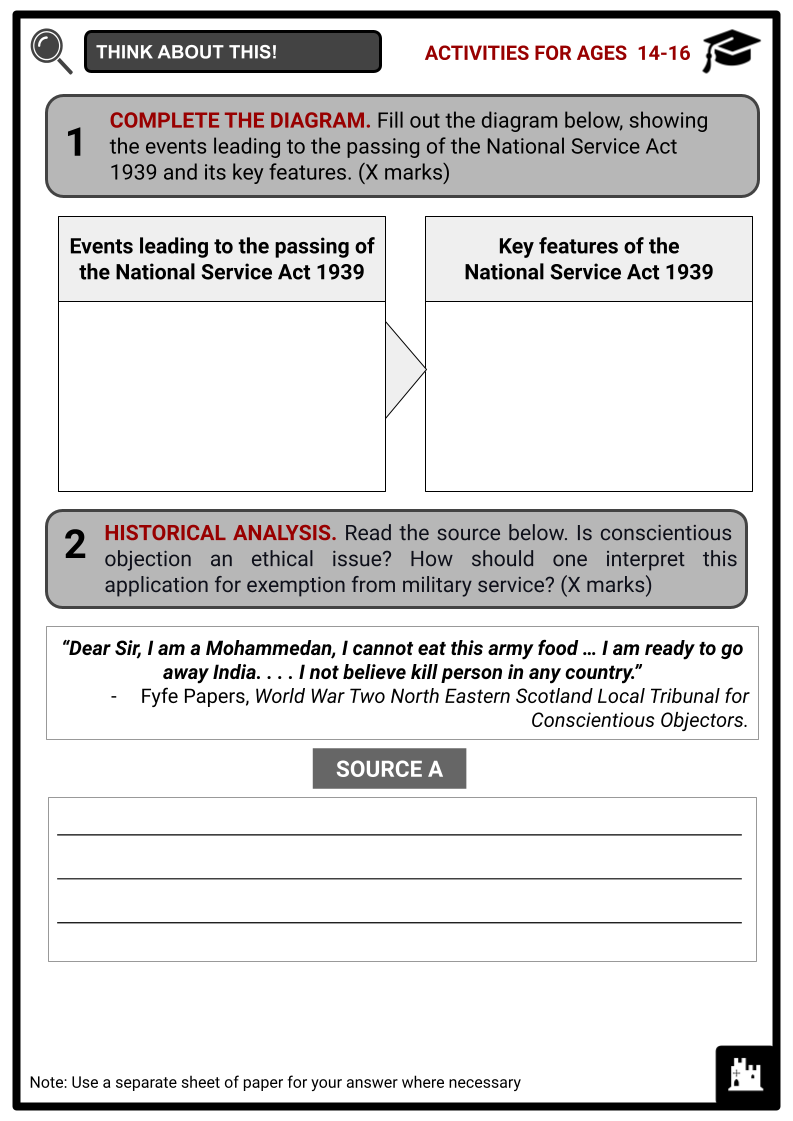
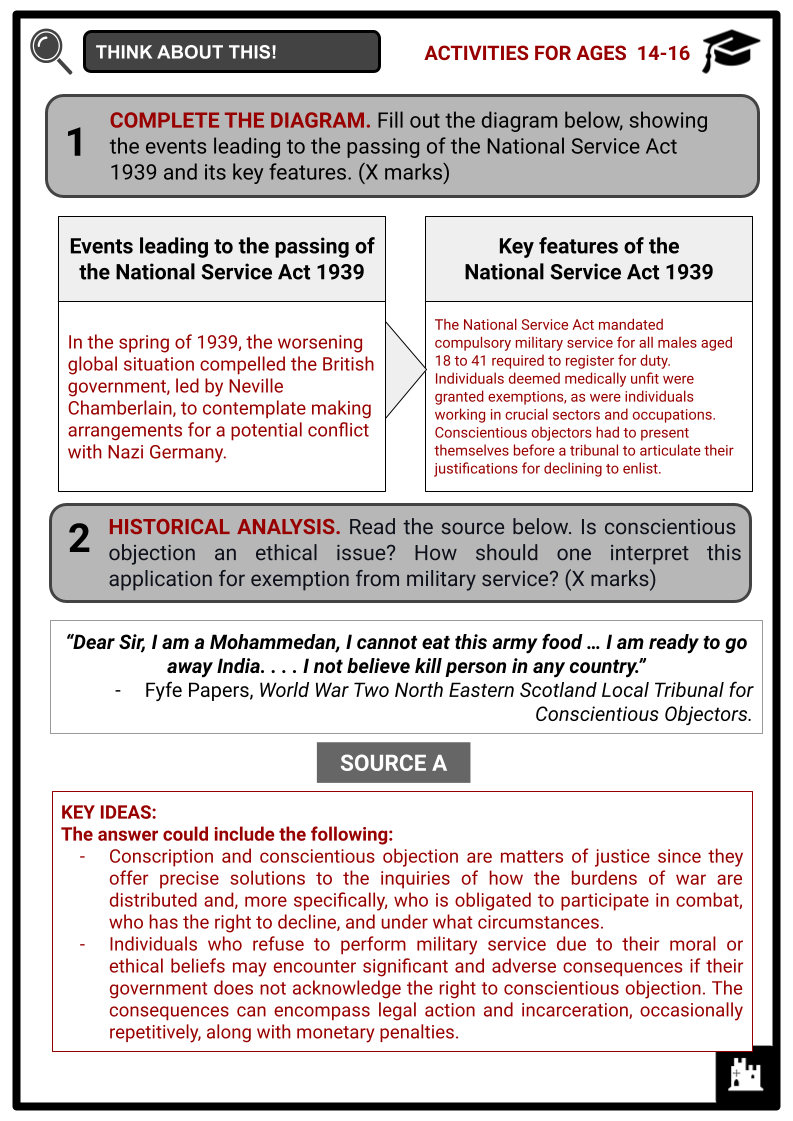
Summary
- Military Training Act 1939
- UK declaration of war on Germany
- National Service Act 1939
Key Facts And Information
Let’s know more about the National Service Act 1939!
The National Service (Armed Forces) Act 1939 was passed by the Parliament of the United Kingdom (UK) on 3 September 1939, coinciding with the UK’s declaration of war on Germany at the onset of the Second World War. The Act replaced the existing Military Training Act 1939. The National Service Act of 1939 mandated compulsory military service for all male British citizens between the ages of 18 and 41 residing in Great Britain, with a few exceptions.
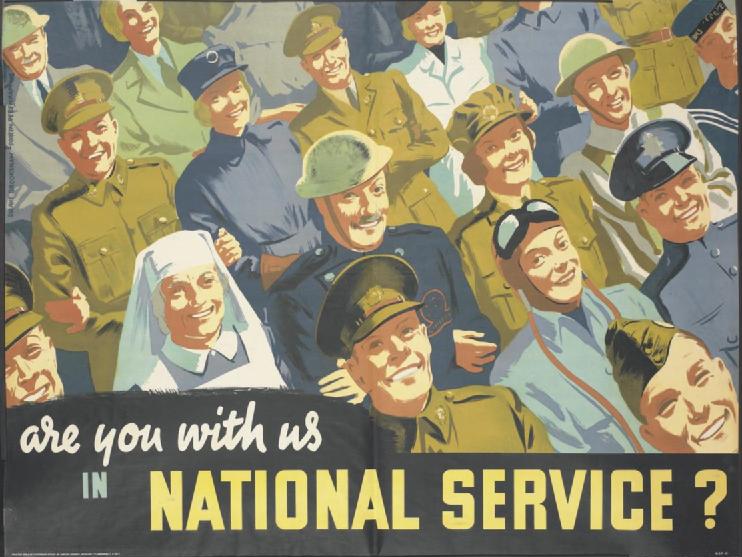
MILITARY TRAINING ACT 1939
- The Military Training Act 1939 was a legislation enacted by the Parliament of the UK on 26 May 1939 during a time of heightened global tension that ultimately resulted in the outbreak of the Second World War. The Act pertained to males between the ages of 20 and 21 who were required to undergo 6 months of intensive military training followed by a transfer to the Reserve.
- The UK implemented its initial peacetime conscription, designed to be transitory and last three years unless an Order in Council deemed it unnecessary. An Order in Council is a type of legislation formally made in the name of the monarch by and with the advice and consent of the Privy Council (King-in-Council).
- On 27 April 1939, Leslie Hore-Belisha, the Secretary of State for War, successfully convinced UK Prime Minister Neville Chamberlain’s cabinet to implement a restricted version of conscription in Great Britain. However, this measure did not extend to Northern Ireland.
- The decision was made in response to the worsening global circumstances and the emergence of Nazi Germany. The vote was contentious since 87% of Members of Parliament (MPs) from the Labour Party opposed the motion as a precursor to conscription, causing the Labour leader Clement Attlee to be visibly furious.
- Men summoned were to be referred to as militiamen to differentiate them from the regular army. Everyone was given a suit and their standard uniform to highlight this differentiation. The initial plan was for the first group to undertake six months of fundamental training before being released into an operational reserve.
- Subsequently, the militiamen would be summoned for brief training intervals and participate in yearly camps. The Act resulted in the registration of the initial group of eligible males on 3 June 1939, and subsequent conscription of these individuals took place. Nevertheless, the Act was replaced by the National Service (Armed Forces) Act 1939 when war broke out in September 1939.
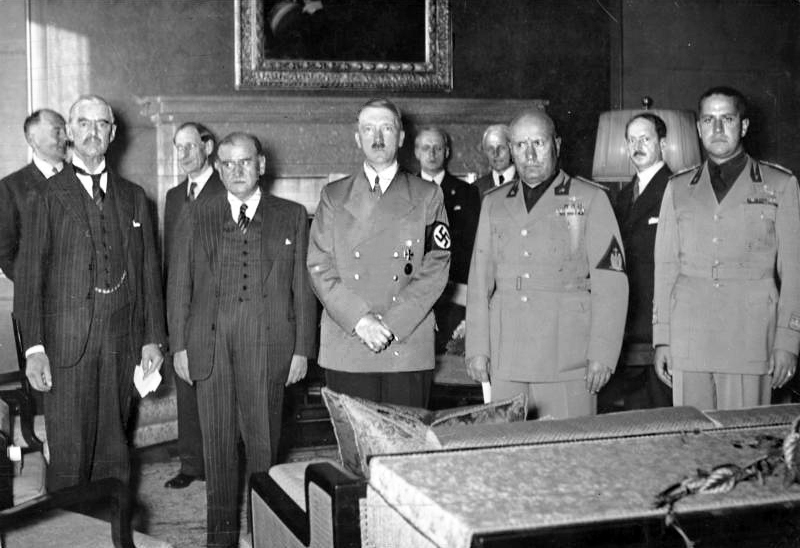
UK DECLARATION OF WAR ON GERMANY
- In the early months of 1939, the probability of another conflict in Europe was steadily increasing. In March 1938, Germany attacked Austria and subsequently seized it. In October of that year, German troops violated the Munich Agreement by occupying the Sudetenland, which was a region belonging to Czechoslovakia.
- The Munich Agreement was a diplomatic accord reached in Munich on 30 September 1938, involving Nazi Germany, Great Britain, the French Republic and Fascist Italy. The agreement stipulated incorporating Sudetenland, a portion of Czechoslovakia, into Germany. This region was inhabited by about three million people, predominantly of German ethnicity.
- The UK government initiated a shift in its policy of appeasement and undertook full-scale rearmament of the British Armed Forces. At the start of the war, the British Army made plans to send a force of two corps, each consisting of two infantry divisions, to France. This was done in preparation for protecting France in a way comparable to the circumstances of the Great War.
- On 29 March 1939, Hore-Belisha declared that the Territorial Army would be expanded from 130,000 to 170,000, and its size would be doubled. Every existing first-line Territorial Army unit and formation had to establish a second-line unit and formation. Despite the individuals stepping forward, there was a shortage of equipment available for them.
- On 1 September 1939, Germany launched an invasion of Poland. As a result, the UK, in accordance with the Polish-British Common Defence Pact, officially declared war on Germany starting on 3 September 1939. As per the terms of the Polish–British Common Defence Pact, the UK was obligated to provide Poland with ‘full support and assistance within its capabilities’ if Poland were to be involved in a conflict with a European nation due to aggression from that nation.
- The British Army commenced mobilisation on 1 September. However, it severely lacked proper equipment and readiness for warfare. Most of the strategy, tactics and equipment originated from the Great War. The initial components of the British Expeditionary Force departed for France on 3 September 1939, a little more than 25 years after its forerunner had traversed the English Channel en route to war.
NATIONAL SERVICE ACT 1939
- In anticipation of a future conflict, the UK Government enacted the National Service (Armed Forces) Bill, which was officially approved by the royal family on 3 September 1939, just five hours after Chamberlain proclaimed a state of war with Germany. The Act replaced the Military Training Act of 1939 and specified that males aged 18 to 41 were obligated to be summoned for military duty in the armed services of the Crown.
Registration Process
- Men were instructed by posters and public advertisements in the press and on the British Broadcasting Corporation (BBC), a British public service broadcaster headquartered at Broadcasting House in London, England, to attend their local office of the Ministry of Labour and National Service (Employment Exchange) on a given date for registration. The instructions were specific to men with defined dates of birth.
- The initial registration occurred on 21 October 1939, specifically for males born between 2 October 1917 and 1 October 1919. Men born between 4 June 1918 and 3 June 1919 who had previously enrolled under the Military Training Act on 3 June 1939 were not included. The Ministry of Labour and National Service clerks documented the personal information of every male attendee, including their age, address, occupation and present employer.
- The National Service Act entitled the men to:
- Indicate a desire to join the Royal Navy or Royal Air Force instead of the Army, with the understanding that there was no assurance that preferences would be accommodated.
- Tentatively enrol as a conscientious objector.
- After completing the registration process, the men were provided with a Certificate of Registration, specifically NS2.
Post-Registration
- The data collected during the registration day was forwarded to an Allocation Local Office for processing. Men who met the age requirements specified in the Schedule of Reserved Occupations and whose employers had obtained permission to delay their military service were allowed to continue working in their current occupation and stay in civilian life.
- Men who were temporarily registered as conscientious objectors were required to remain in civilian life until they applied to their local tribunal for a case hearing within 14 days. Neglecting to do so led to their name being eliminated from the register. The remaining individuals, who were considered eligible for military duty, stayed in civilian life until further instructions were given.
- Men eligible for military duty were mandated by their Allocation Local Office to undergo a physical examination conducted by a medical board. Each Allocation Local Office was equipped with Medical Boards, accompanied by recruitment personnel from the different forces.
- Men were evaluated and ranked based on their level of physical fitness. Individuals in Grades I, II and III were considered to be suitable for the armed services, although they would serve in different roles. However, Grade IV individuals were considered unsuitable for military service.
- At this juncture, men had the option to request a delay in their obligation to serve in the military due to severe difficulties by submitting an application for a postponement certificate (Form NS13) within two days following their medical examination. Each case was evaluated by a local committee that assessed the difficulty level.
- After finishing their assessment, they were interviewed by a recruitment officer from the armed force they had chosen or been assigned to. The men, once again, continued to live freely, awaiting further instructions.
Request for Personnel
- The Ministry would receive a list of staffing requirements from each service and then assign a certain quota to each divisional office. With assistance from the recruiting officers of each service, the divisional offices would pair the individuals on their registry with the requests made by the three services.
Exemptions
- Individuals who were medically unfit, visually impaired, physically disabled or had a mental illnesses
- Non-resident British citizens who had resided in the country for less than two years, except those outside Britain and the Isle of Man
- Students
- Civil servants of any British Empire country, excluding the United Kingdom
- Members of the clergy from any religious denomination and women who were married
- Women with at least one child who was 14 years old or younger and residing with them. This encompassed their biological offspring, whether born within or outside of marriage, their stepchildren, and any children they had legally adopted, provided the adoption took place before 18 December 1941. Pregnant women were eligible to be summoned, but they were not.
- Although the war ended in September 1945, the Labour administration maintained the Act until 1948. At that time, the effects of the Act were extended in a modified version through the implementation of the National Service Act 1948.
Frequently Asked Questions
- What was the National Service Act of 1939?
The National Service Act of 1939 was a legislation passed by the Parliament of the United Kingdom, which introduced conscription for military service for men aged 18 to 41 during World War II.
- Why was the National Service Act 1939 implemented?
The Act was implemented due to the escalating tensions and outbreak of World War II, as the British government needed to bolster its military forces to defend against potential threats.
- Who was required to serve under the National Service Act 1939?
Male British citizens aged 18 to 41 must register for potential military service under the Act.
